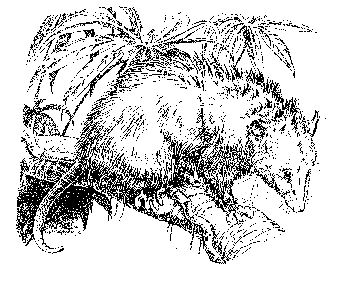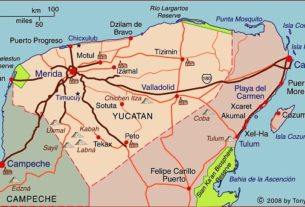Tlacuaches (opossums) are short-lived but smarter than most people imagine…
Imagine “a monstrous beast with a snout like a fox, a tail like a marmoset, ears like a bat, hands like a man, and feet like an ape, bearing her whelps about with her in an outward belly much like a large bag or purse.”
This marvelous description comes from an account written in early Spanish colonial times and is quoted by Austad in Scientific American.
It might seem strange, but this primitive-looking marsupial animal, with a pouch like a kangaroo, proved to be an astonishingly successful colonizer of new territory. The opossum (tlacuache) has spread more than 800 kilometers further north than its distribution at the time of the Conquest, well into the U.S. Its success has been partly due to a pacific co-existence with humans, eating garden refuse and rubbish, but not damaging crops. In addition, it has a remarkable talent for finding food and remembering exactly where it was found. In laboratory tests opossums out-remember cats, chicks, dogs, goats, pigs, turtles and even rats!
Most people associate marsupial animals with Australia, but there are about 80 species of marsupials, or 30% of the world total, in Central and South America. In North America (which some biologists believe was the original home of all marsupials some 100 million years ago), they became temporarily extinct until their re-advance northwards from South America, across the Panama land bridge, about three million years ago.

The common opossum ( Didelphis marsupialis) is sometimes divided into two distinct races: the white-cheeked Virginia opossum ( D. virginiana), in the U.S., northern and western Mexico; and the dark-cheeked Mexican opossum ( D. mesoamericana), found further south. The variation may have occurred as a result of fluctuating climates in the Ice Ages. Opossums spread into the mountains of Western Mexico during warm periods, but retreated to sheltered lowland valleys when it became colder. The eventual result was D. virginiana, well adapted to cooler climates.
In southern Mexico there are several other tlacuaches, or marsupials, including the wooly opossum, a little-studied tree dweller; the tlacuache cuatro ojos, or 4-eyed opossum, which has no pouch for its young; and the big water opossum, first recognized about 50 years ago, similar in size to the common opossum but with webbed feet.
The common opossum is the size of a house cat, with a long, pointed nose, round ears, short legs, and is predominantly grey in color. Females have a pouch for their young. Opossums look bigger than they actually are because of their long hair. They have the reputation of being slow and lazy, but inquisitive. Their hands and feet are perfectly adapted for tree-climbing. Each foot has 5 toes, and their hands have thumbs opposite their fingers. In climbing, they make frequent use of their prehensile tail. One of their characteristic behaviors is to “play possum”, feigning death when threatened.
Tlacuaches are nocturnal and are often seen running across the road or standing indecisive on the verge, panting when caught in a vehicle’s headlights. They are also often heard scrambling over roofs in search of potential food. They are omnivorous. A large part of their diet is insects and other invertebrates, but they also eat the eggs of chickens and wild birds, fruits and berries. Before complaining about your neighbor’s cat and its nocturnal excursions across your roof tiles, consider the possibility that it might not be a cat at all, but a tlacuache, or opossum.
Tlacuaches make their homes in hollow trees, or beneath constructions, sometimes using the empty burrows of rabbits or armadillos. They transport material for their nests with their tails rather than their feet. They are not a very social animal, and are rarely seen together except during the mating season.
Despite their canny food-finding abilities, opossums are among the shortest-lived mammals in the world for their size. A Venezuelan study found that only 1.2 % lived to a third reproductive season and none to a fourth. Any tlachuache that lives beyond its first reproductive year shows signs of advanced aging, such as cataracts, weight loss, and a loss of motor coordination.
Baby tlacuaches are tiny, less than one centimeter long and weighing only a fifth of a gram at birth, 1/10,000th of the body weight of their mother. They are born deaf and blind and virtually devoid of hind legs, but nonetheless have to find the marsupial pouch, five centimeters away, using their front feet in a kind of swimming motion known to scientists as the Australian crawl. If successful, they attach to one of their mother’s teats for about 2 months. Of the average litter of twenty, less than half survive early childhood.
Interesting survivors of ancient times that they are, tlacuaches have limited economic significance. If no alternative source of meat is available, rural campesinos will sometimes eat them, but more often they make use of their skin or the fat from their tail, considered since Aztec times to have some medicinal value.
Sources:
- Austad, Steven N. The Adaptable Opossum. Scientific American, February, 1988, pp. 54-59.
- Gardner, A. L. (1983) Didelphis marsupialis, in Janzen, D. H. (1983) Costa Rican Natural History. University of Chicago Press.
- Leopold, A. S. (1959) Wildlife of Mexico. University of California Press.
Copyright 2004 by Tony Burton. All rights reserved.




Your blog post about tlacuaches (opossums) was a fascinating read! As someone intrigued by Mexican wildlife and culture, your exploration of these unique creatures shed light on their role and significance in the ecosystem. I appreciated the blend of natural history and cultural anecdotes, making it both educational and entertaining. Quick question – do you have any personal encounters or stories involving tlacuaches that you’d like to share? Thanks for sharing your passion for Mexico’s diverse wildlife with us!